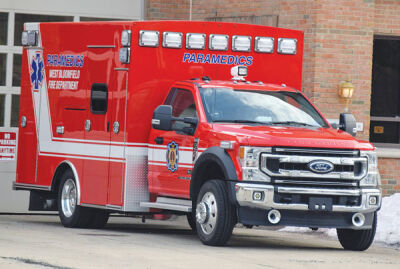
The West Bloomfield Fire Department was one of multiple departments in Michigan to be alerted following the mass shooting on the campus of Michigan State University Feb. 13.
Photo provided by the West Bloomfield Fire Department
WEST BLOOMFIELD — Following the mass shooting that took place on the campus of Michigan State University Feb. 13, several emergency responders from across the state headed to East Lansing in an attempt to provide whatever assistance might be needed.
Among the respondents was the West Bloomfield Fire Department.
“Most fire departments knew very early on … that a very serious incident had occurred and was continuing to occur in East Lansing on the MSU campus, and several departments sent personnel to East Lansing to assist the East Lansing and Lansing fire departments — within an hour and a half arriving in East Lansing,” West Bloomfield Township Supervisor Steven Kaplan said. “We sent an ambulance, and that ambulance had two firefighters, Carly Mocny and … Bryan Jewell.”
Three people died and five were injured as a result of the mass shooting.
The shooter, who died from a self-inflicted gunshot wound, was identified as Anthony McRae.
The West Bloomfield Fire Department responded after being alerted via the Michigan Mutual Aid Box Alarm System, known as MABAS, which coordinates intrastate and interstate mobilization and deployment of fire, emergency medical services, and special operations mutual aid resources during natural and man-made emergencies and disasters, according to the MABAS website.
“Anytime something happens where more resources are needed, we all work together to accomplish the goal,” said West Bloomfield Fire Department Capt. Jeff Latkowski. “So, if (an) event happened here in West Bloomfield that was bigger than what we could handle with our on-duty crews, we would activate a MABAS, which would give us resources from other departments. … As soon as that event (in East Lansing) went down, a MABAS was activated. We were able to quickly send a rescue crew with firefighter Mocny and firefighter Jewell to help assist with the tragic events.”
West Bloomfield Fire Department Fire Marshal Byron Turnquist described Mocny and Jewell’s role after arriving.
“They arrived on-scene at the staging area; they helped set up and coordinate, prepare, if it became necessary, that they had multiple rescue task force teams that needed to be deployed to rescue people,” Turnquist said. “They did a lot of preparing, tracking of the resources, and figuring out who’s where, who brought what, and then they were able to kind of turn it all off and get everybody sent home and bring (an) end to the incident. I don’t believe any Oakland County crews actually responded to any patient.”
Mocny, who along with Jewell is also a West Bloomfield Fire Department paramedic, provided further details.
“We received a mutual aid request from, I assume, East Lansing,” she said. “The shift captain contacted me and my fellow crew member, Bryan Jewell, to see if we were able to go up to East Lansing, and we were sent. … We got sent sometime in the evening, and we were asked to report to staging. When we got up there we met in the staging area with several other … EMS, fire agencies from around Michigan, and that’s kind of where we stayed.”
Mocny estimated that it took about an hour and 20 minutes to arrive at the staging scene. She and Jewell arrived without having all of the details.
“We very rarely have all the information, so all we knew was that there was some sort of active shooter incident,” Mocny said. “We didn’t even have the exact number of people who were injured. So, we get very little information and just kind of respond, and then we kind of learn more information at a need-to-know (basis).”
Mocny said that she and Jewell were in a staging area off-scene, approximately a mile or two from the incident. Despite having received training for active-shooter incidents, the location of the shootings held a special significance for Mocny.
“For me in particular it was very sad,” she said. “I am actually a graduate of Michigan State University, so it was very sad for me to be responding to that type of incident at my alma mater, but overall, I think … everybody there was ready to do what they had to at a moment’s notice and everybody was well prepared.”
Mocny said that she and Jewell were at the staging area for approximately an hour or two.
“Thankfully, they didn’t need us,” she said.
Turnquist described how the process works after getting an alert from MABAS.
“Immediately after we received the call we were able to mobilize and get en route to East Lansing, and I believe from this area we were one of the first units to be on-scene,” he said. “Firefighter Mocny (has) been involved in training our department firefighter/paramedics, and even some of our police officers with what we call the rescue task force, which is how we work together with each other on these types of incidents to give medical care, and the police are there to protect us. She was recognized by one of the incident commanders or staging officers in that area, and they charged her with coordinating some of those teams and preparing for what might be needed.”
Latkowski provided insight as to whether or not lights and sirens are used in situations in which a potential emergency is a long distance away.
“We would treat that just as if it was in our township here,” he said. “So, we would respond appropriately to whatever that emergency is. Really, any way we would do it here, we would do it elsewhere in another community.”
Turnquist said that for an incident such as what happened in East Lansing, a call goes into the MABAS system, “which is a number that they call and dial, and that request gets sent out to the appropriate resources.”
He shared how technologically advanced things have become in recent years.
“I’ve been with the department for over 26 years, and Capt. Latkowski’s got 21 years, and we’ve seen a lot of changes,” Turnquist said. “We have iPads on our fire trucks, which gives us GIS mapping, gives us aerial photos, gives us pre-plan information — stuff that used to be manually updated and xeroxed, and placed in three-ring binders that were hard to read at night. So, we’ve come a long way there, as far as being able to organize these large-scale incidents and reaching out to neighboring communities in getting appropriate resources that you might need. I would say over the last 10 to 15 years we’ve really grown there … and departments have understood or accepted the fact that they can’t always handle everything themselves, and nobody’s shy to ask their neighbor for help, because we’re always willing to help out when needed.”
Turnquist said that being able to network with other communities has made a huge impact.
“You want to commend the incident commanders and the people that had boots on the ground immediately in Lansing — not knowing exactly what was going on yet on the campus, and realizing the potential of how bad it could’ve been, they reached out extremely early in the incident to get the resources there, rather than find out that they have a whole bunch of injured people and wait an hour or more to get the resources,” he said. “So, it’s beneficial for us to call for help early, before we know exactly what we need, because it’s always easy to turn that around and say, ‘We’re all set; thanks for coming.’ … They did what was appropriate and got everybody moving early on.”
Kaplan took notice of the unity between varying departments.
“It shows camaraderie and teamwork, partnership, that the various fire departments will provide aid to one another in times of peril,” he said.
 Publication select ▼
Publication select ▼
























